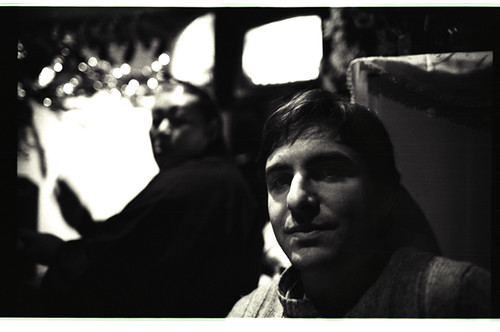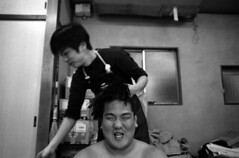High and Low
This move to a more egalitarian Japan, less bound to its inflexible hierarchies, is generally seen as a good thing. Just about the only good news you read about the Japanese economy these days are success stories about companies who shed their ossified leadership structures and patronage systems so they can listen to their young innovators and let in outsiders.
But in the sumo world, the stratification that is fading from contemporary Japanese life is explicit. It doesn't just determine the honorific with which one is addressed; it determines the very quality of one's life. Where you stand in the pecking order determines whether you'll have to bathe another, or will be bathed; whether you'll have to cook for another or will be cooked for; whether you'll be subjected to arbitrary beatings, or will administer those beatings yourself.
The stratification serves a practical function, I guess. It provides a tangible incentive to the lowly to get bigger, stronger and meaner so they can progress through the ranks and escape having to wait on the Sekitori. And the more high-ranking wrestlers a stable has, the more money and prestige it earns
I'll bet that, once you get to know him, the Sekitori probably isn't even such a bad guy. He probably spends so much time holed up alone in his room because he gets tired of being a creep. Being responsible for the torture and humiliation of a sprawling house full of overweight jocks is hard work. But it's part of his job description and the prerogative of his rank.
I assume the Sekitori is nice to me because he can be. I'm not included in the hierarchy that organizes the stable's social life. Going into this project, I wanted to be treated like a new recruit. But I now realize that that was an impossible request. Demeaning an outsider like me would compromise the symbolic power of the humiliation that's regularly meted out.
I also now realize that, for my purposes, the position I hold outside the hierarchy is preferable to being a rookie. Outside of the pecking order, I have access to its levels that none of the actual residents here enjoy. I can walk into any situation: I get to hang out with my high-ranking roommates, get treated to dinner by the Kashira, shoot the breeze with the Sekitori, watch variety shows in the common room with the young, low-ranking guys.
But the low-ranked guys, say, couldn't pop into the bedroom where I sleep for a chat with my roommates. And the Sekitori couldn't hang out in the common room with the low-ranked guys watching television, not without abusing them at least. They have to remain within their castes.
It's actually odd that such a stiff hierarchy exists in the sumo world. The sport emerged from an explicitly status-resistant milieu, the "floating world" demimonde of 17th and 18th century Japan. This world existed in codependency with its mirror image, the official Japan of the Edo-era shogunate.
The shogun's Japan, with its neo-Confucian underpinnings, was nothing if not stratified. A strict pecking order divided up Japan's rulers, its nobility and its farmers, with its townspeople and merchants at the bottom of the heap. Strict sumptuary laws reserved the finest fabrics and brightest colors for those with the most prestige, while travel restrictions limited geographical movement.
But in addition to enforcing this strict social organization, the shogun also kept its feudal nobility—the samurai—from regaining power by forcing its members to spend much of their time in the city of Edo, now Tokyo, where he could keep an eye on them. He also made feudal lords keep their families in residence in Edo as his virtual hostages. Their presence in the city generated an increasingly affluent merchant class to provide for their extravagant needs. By the mid-18th century, this conglomeration of samurai and city dwellers had made Edo the world's most populous city.
So, what do you get when you pack a city to the gills with bored samurai and nouveau riche urbanites? In Edo's case, it was a high demand for brothels, to which the shogunate responded by licensing a red-light district on the edge of the city, where it would least harm the established social order. A massive entertainment district soon sprung up around the brothel quarters, with areas of competing grandeur coming to life around the licensed brothels on the peripheries of Japan's other large cities. They were glittery, rough-and-tumble place, full of hoaring and gambling, flamboyant entertainment and audacious behavior. They were probably a lot like Las Vegas, just with people going to see kabuki performances instead of David Copperfield.
In the "floating world," as these pleasure quarters were known, official status didn't matter. What counted was how much money you had and how cool you were. There was a word for the Edo ideal of refined coolness: tsuu. If you had tsuu, you knew which whorehouses and drinking holes were the classiest and understood exactly how to behave in them. You could show up at a bar, scribble out a sophisticated haiku, drain a few bottles of the best sake without getting drunk, then walk out with the prettiest girl (or bed down with the most sought-after prostitute). If Dean Martin had been an "Edokko"—a child of Edo—he'd have had tsuu, which counted more than official status in the pleasure quarters of the time.
And it was exactly into this milieu that sumo was born. One of the floating world's entertainments was street-corner prizefighting, whose combatants included disenfranchised samurai and migrants from the countryside. True, wrestling has a long history in Japan and is even mentioned in the country's genesis mythology. And temples and shrines often hired these strongmen to perform on their grounds, as a way to raise money, giving them an association with religion. But make no mistake about it: these were rough, raw, brutal competitions, and were sometimes fought to the death.
But toward the end of the 18th century, sumo underwent a stunning transformation. At the time, the bloody street-side matches were in danger of being banned by the ruling shogun's moral-values crusade. Led by the scion of an established Edo family, who claimed to have inherited the secrets of sumo linking it to 12th century court wrestling, a contingent of fight promoters petitioned the shogun to let the show go on. The shogun relented, and soon sumo matches were even being held in his castle. Sumo, now dressed up in the trappings of Japan's semi-official religion, Shinto, had been fully rehabilitated into a representation of the Japanese spirit. Wrestlers were even summoned to greet—or intimidate—Commodore Matthew Perry and his fleet of Black Ships that ended Japan's centuries of shogun-enforced isolation.
When sumo was taken out of the floating world and established as part of the official culture, it must have absorbed the stratification of the shogun's Japan, which has fossilized into the hierarchy that exists in sumo today. And, considering that this Edo-style stratification exists in the sumo world while it rapidly disappears from contemporary Japanese life, sumo may really have become the vessel of traditional Japanese values that its 18th century rehabilitators imagined it to be.
Granted, the sumo hierarchy is less static than that of Edo Japan: it's a meritocracy, if a brutish one. But let's not forget that the warlords who began the project of national consolidation, which the shogun completed, weren't great nobles themselves. They were brutes from humble families who dominated the country through violence and cunning, much like the wrestlers win their matches.
NEXT: Chanko Nabe



